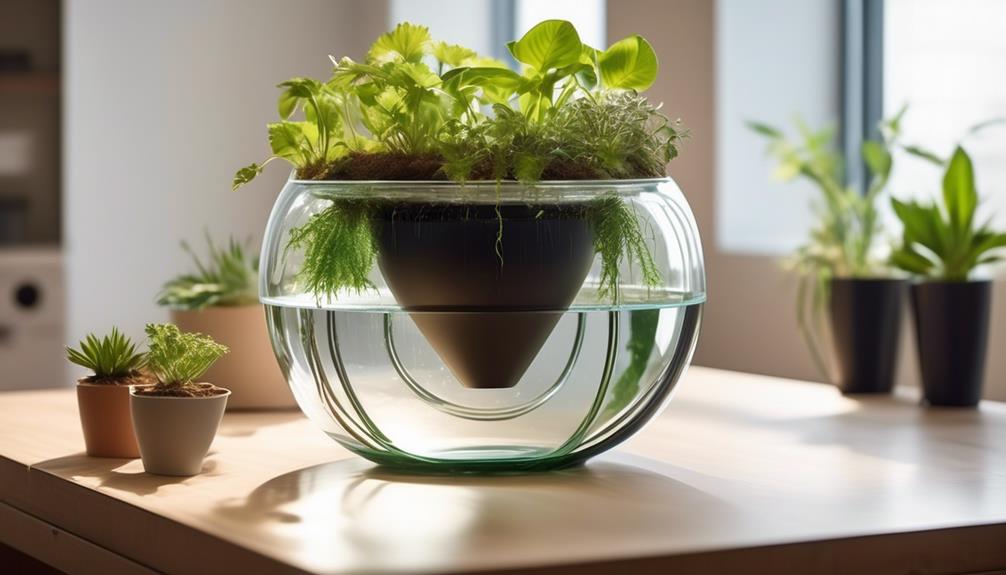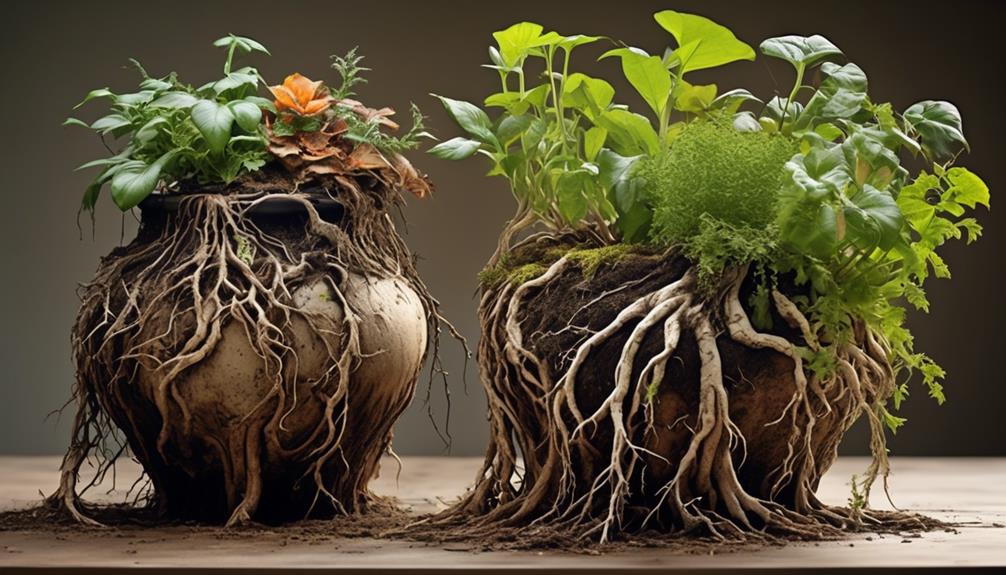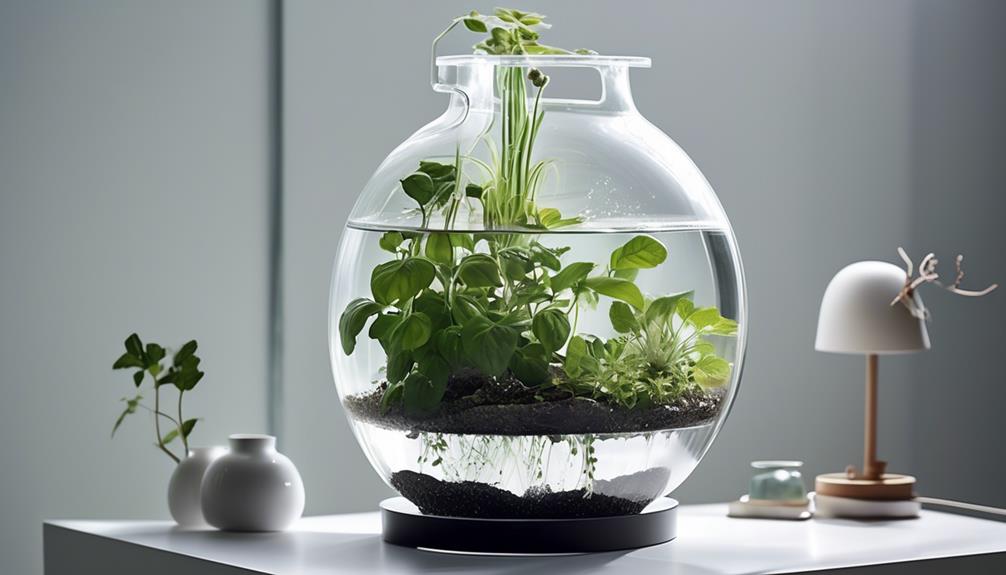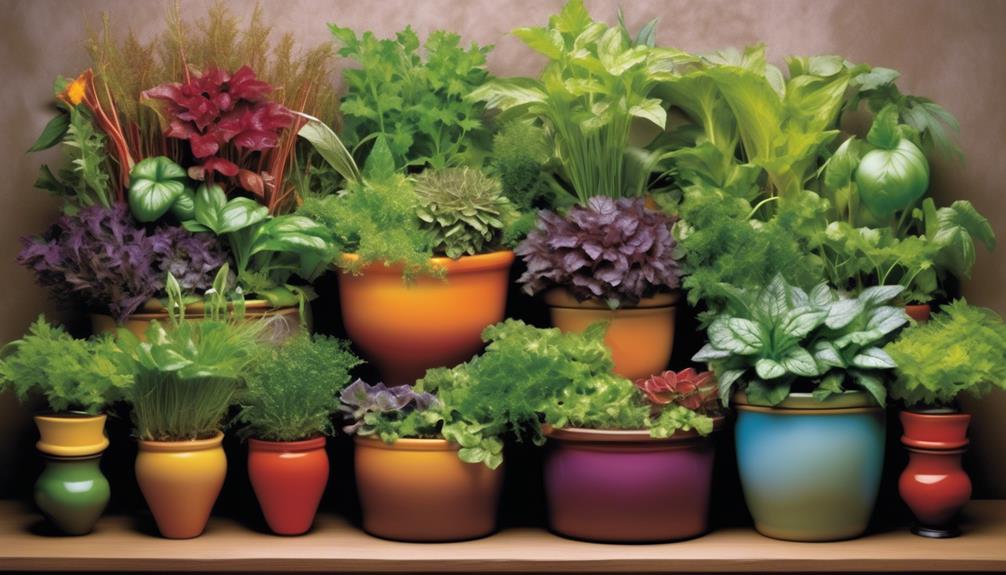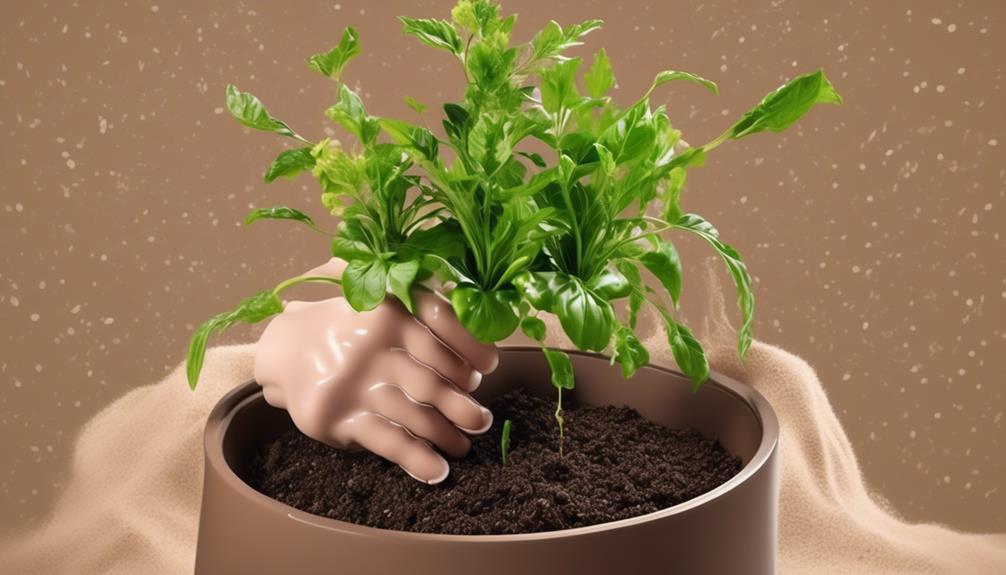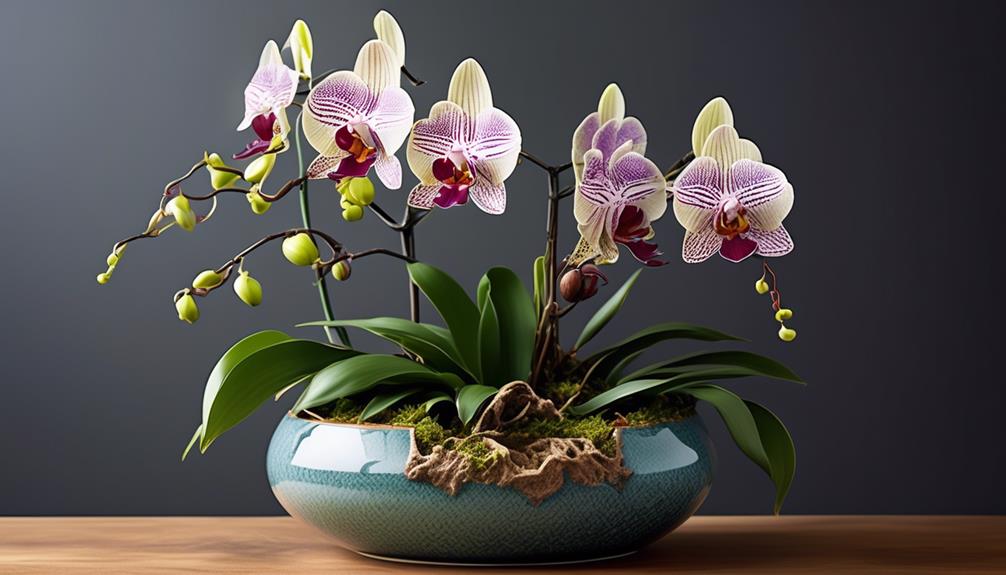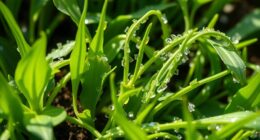Many people have encountered assertions that self-watering planters function as a personal caretaker for your plants. However, do these claims have solid evidence to support them? Together, we have delved into the scientific basis of these advanced planting systems to uncover the reality of their efficacy.
Are they a game-changer for plant enthusiasts or just another gimmick? Join us as we delve into the world of self-watering pots and separate fact from fiction.
Key Takeaways
- Self-watering pots use a reservoir system to supply water to the soil as needed.
- They prevent overwatering by supplying water only when needed, promoting robust root growth and overall plant health.
- Self-watering pots ensure a consistent moisture level in the soil, reducing the risk of over or under-watering.
- Regular monitoring and maintenance are necessary to maintain healthy soil moisture levels and promote optimal plant growth.
The Science Behind Self-Watering Pots
Self-watering pots function by utilizing a reservoir system that supplies water to the soil as needed, promoting optimal moisture levels for plant growth. The watering frequency is determined by the moisture level in the soil, which is monitored by the pot's design. When the soil becomes dry, a wicking mechanism draws water from the reservoir into the soil, ensuring consistent plant hydration. This system prevents overwatering, a common issue with traditional pots, by supplying water only when the plant needs it.
The science behind self-watering pots lies in their ability to maintain a balanced soil moisture level, crucial for plant health. The reservoir system creates a self-regulating environment that allows for the gradual release of water, preventing sudden spikes or drops in moisture. This consistency in plant hydration is essential for promoting robust root growth and overall plant health.
Understanding the intricacies of self-watering pots empowers plant enthusiasts to create an optimal environment for their green companions. By harnessing the scientific principles of water distribution and plant hydration, these pots offer a sophisticated solution for maintaining healthy and thriving plants.
How Self-Watering Pots Function

Utilizing a reservoir system and a wicking mechanism, self-watering pots maintain optimal soil moisture levels by supplying water to the plants as needed.
The watering mechanism explanation includes the following key points:
- Reservoir System: Self-watering pots have a separate reservoir that holds water beneath the soil. This reservoir is designed to store excess water, preventing the soil from becoming waterlogged while ensuring a constant supply of moisture to the plant's roots.
- Wicking Mechanism: A wick, usually made of fabric or rope, extends from the reservoir into the soil. Through capillary action, the wick draws water from the reservoir and delivers it directly to the plant's roots, ensuring a steady and consistent supply of water.
- Self-Watering Pot Maintenance: To maintain the effectiveness of self-watering pots, it's essential to regularly monitor the water level in the reservoir and refill it as needed. Additionally, periodic checks of the wick to ensure it's clean and unobstructed are crucial for optimal function.
Understanding the intricacies of the watering mechanism and the necessary maintenance allows for the efficient use of self-watering pots, ensuring healthy and thriving plants.
Benefits of Self-Watering Pots
With the understanding of how self-watering pots function and their maintenance requirements in mind, we can now explore the numerous benefits that these innovative containers offer for plant health and growth.
Self-watering pots provide exceptional watering efficiency by ensuring a consistent moisture level in the soil, which is crucial for plant growth. These pots utilize a reservoir system that allows plants to draw water as needed, reducing the risk of over or under-watering. This efficient water delivery system also minimizes water wastage, making self-watering pots an environmentally friendly choice.
Another benefit of self-watering pots is the flexibility they offer in plant selection. The consistent moisture levels created by these pots make them suitable for a wide range of plants, including those with specific watering needs. This opens up opportunities to cultivate a variety of plants, from moisture-loving ferns to drought-tolerant succulents, in the same type of container.
Additionally, the reduced frequency of watering required by self-watering pots makes them ideal for busy individuals or those with limited mobility.
Factors Affecting Pot Effectiveness
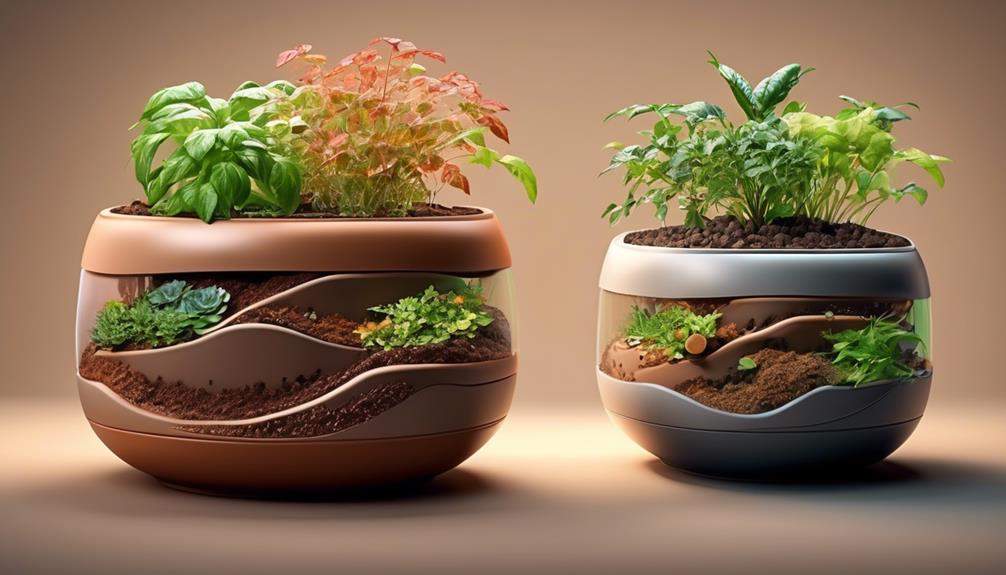
Considering the various factors that can influence the effectiveness of self-watering pots, it's essential to evaluate the material composition of the pot itself. The material of the pot can significantly impact its ability to maintain proper moisture levels and support plant growth.
Factors affecting pot effectiveness include:
- Porosity: The porosity of the pot material determines how much water it can hold and how quickly it can release moisture to the plant's roots. High porosity materials like terracotta may require more frequent refilling, while less porous materials like plastic can retain moisture for longer periods.
- Insulation: The insulating properties of the pot material can affect the soil temperature, which in turn impacts plant growth. Materials that provide better insulation can help maintain optimal soil temperatures, promoting healthier root development and overall plant vigor.
- Durability: The longevity and structural integrity of the pot material are crucial for sustained watering efficiency. Durable materials can withstand environmental stressors and ensure the long-term functionality of the self-watering system.
Understanding these factors is essential for maximizing pot effectiveness, promoting healthy plant growth, and optimizing watering efficiency. Selecting the right material for a self-watering pot can make a significant difference in maintaining a thriving and sustainable plant environment.
Choosing the Right Potting Mix
When choosing the right potting mix for self-watering pots, we need to consider its moisture retention and nutrient availability.
The potting mix should be able to hold onto moisture for extended periods to support the self-watering system.
Additionally, the mix should provide essential nutrients for the plant's growth and development.
Potting Mix Moisture Retention
Choosing the right potting mix is crucial for ensuring optimal moisture retention in self-watering pots. When it comes to potting mix moisture retention, consider the following:
- Watering frequency: The composition of the potting mix directly impacts how often you need to water your plants. A mix that retains moisture well can reduce the frequency of watering, providing a more stable environment for plant roots.
- Evaporation rates: The ability of the potting mix to retain moisture also affects evaporation rates. A high-quality mix with good moisture retention properties can slow down evaporation, ensuring that the plant roots have consistent access to water.
- Soil structure: The physical structure of the potting mix plays a significant role in moisture retention. Look for mixes with a balanced ratio of organic matter, such as peat or coconut coir, and inorganic materials like perlite or vermiculite to create an ideal environment for moisture retention.
Nutrient Availability in Mix
To ensure optimal nutrient availability in the potting mix, it is essential to select a blend that provides a balanced array of essential plant nutrients without compromising moisture retention properties. When choosing a potting mix, consider the nutrient content and the watering frequency required for your specific plants. The table below outlines key nutrients and their functions, aiding in the selection of an appropriate potting mix for your plants.
| Nutrient | Function |
|---|---|
| Nitrogen | Essential for leaf growth |
| Phosphorus | Promotes root development |
| Potassium | Aids overall plant health |
| Calcium | Supports cell structure |
| Magnesium | Essential for photosynthesis |
Understanding Water Reservoirs
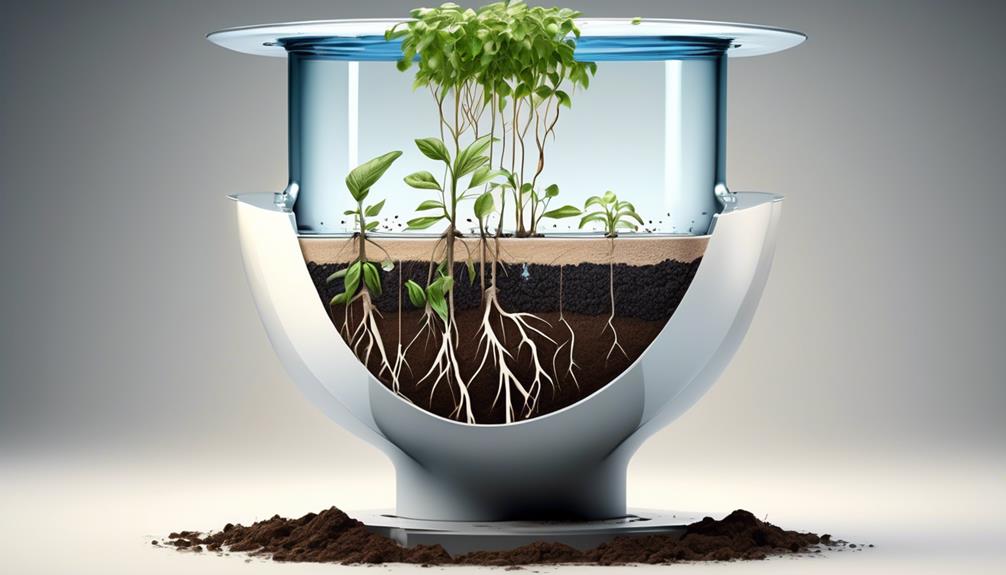
In self-watering pots, the water reservoir is a key component designed to provide a consistent and regulated supply of water to the plant's roots. Understanding the function and importance of water reservoirs is crucial for maximizing the benefits of self-watering pots.
Here are three key points to consider:
- Watering Frequency: The water reservoir in self-watering pots helps to regulate watering frequency by providing a continuous supply of water to the plant's roots. This can be particularly beneficial for plants that require consistent moisture levels, as it helps to prevent overwatering or underwatering, leading to healthier root systems.
- Root Health: The design of the water reservoir promotes healthier root development by allowing the roots to access water as needed. This constant access to water encourages the roots to grow deeper into the growing medium, leading to a stronger and more robust root system. Additionally, the regulated moisture levels can help prevent root rot and other water-related issues.
- Moisture Regulation: The water reservoir acts as a buffer against fluctuations in moisture levels, providing a more stable environment for the plant's roots. This stability can enhance overall plant health and resilience, especially during hot or dry periods.
Understanding the role of water reservoirs in self-watering pots is essential for harnessing their full potential and promoting optimal plant growth.
Maintenance Tips for Self-Watering Pots
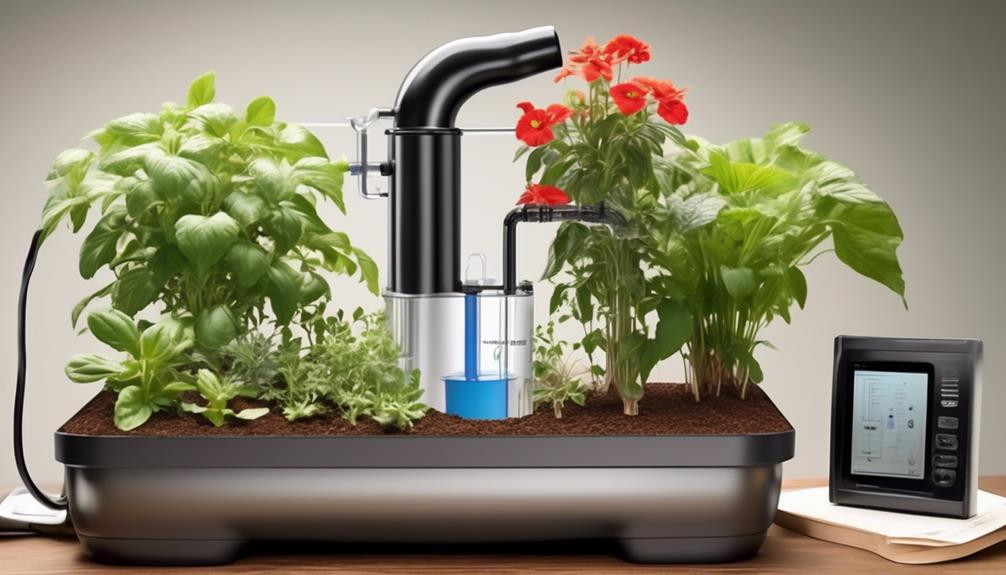
When maintaining self-watering pots, it is important to regularly monitor the water levels in the reservoir to ensure consistent and adequate hydration for the plants. This involves checking the water level indicator or physically inspecting the reservoir to avoid overfilling or allowing it to run dry. Additionally, understanding the watering frequency and soil moisture requirements of different plants is crucial for effective maintenance. Here are some essential maintenance tips for self-watering pots:
| Maintenance Tips | Details | Importance |
|---|---|---|
| Monitor Water Levels | Check the water level indicator or reservoir regularly | Ensures proper hydration |
| Adjust Watering Frequency | Adapt to the specific needs of different plant species | Prevents over/under watering |
| Check Soil Moisture | Use a moisture meter or visually inspect the soil | Ensures optimal growing conditions |
Common Myths Debunked
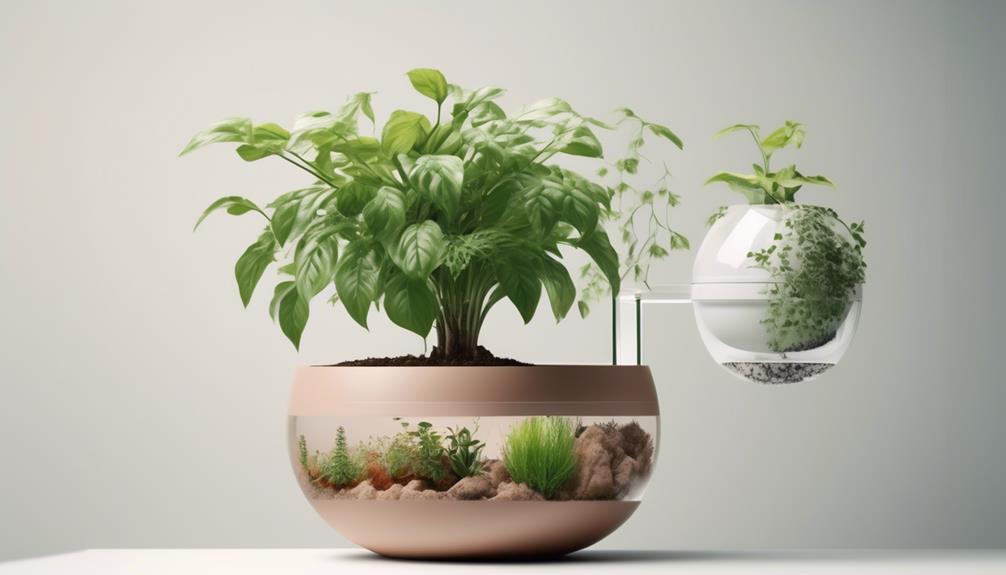
Debunking common myths surrounding the effectiveness of self-watering pots requires a critical examination of their functionality and practical implications.
Here are three misconceptions about self-watering pots that need to be addressed:
- Self-watering pots overwater plants: One common misconception is that self-watering pots lead to overwatering. In reality, these pots have a reservoir that holds excess water, preventing the soil from becoming waterlogged. The wicking system draws water up into the soil as needed, providing plants with consistent moisture levels without the risk of overwatering.
- Plants become dependent on self-watering pots: Some believe that plants grown in self-watering pots become reliant on the continuous water supply, making them less resilient. However, self-watering pots promote healthy root growth by allowing plants to access water as needed. This actually helps plants develop stronger root systems and enhances their ability to withstand periods of drought.
- Self-watering pots are only suitable for certain plants: Another misconception is that self-watering pots are limited in their practical applications. In fact, these pots are suitable for a wide range of plants, including vegetables, herbs, and flowering plants, making them versatile options for gardeners and indoor plant enthusiasts.
Comparing Self-Watering Vs. Traditional Pots
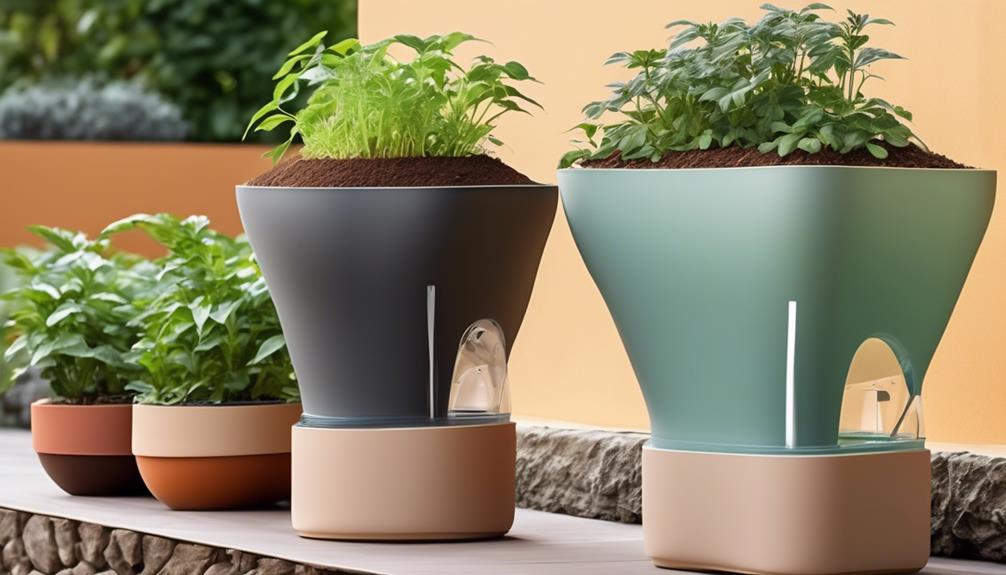
When comparing self-watering pots with traditional pots, it's crucial to consider their watering efficiency, plant health benefits, and maintenance convenience.
By examining these three key points, we can gain a comprehensive understanding of the effectiveness of self-watering pots in comparison to traditional ones.
This analysis will provide valuable insights into the practical implications of using self-watering pots for plant cultivation.
Watering Efficiency Comparison
In evaluating the watering efficiency of self-watering pots versus traditional pots, it's essential to consider key factors such as water usage, moisture retention, and plant hydration.
Watering frequency: Self-watering pots generally require less frequent watering due to their reservoir system, which provides a consistent water supply to the plants.
Plant growth: Studies have shown that self-watering pots can promote better plant growth due to their ability to provide a steady moisture level, which is crucial for root development and overall plant health.
Water conservation: Self-watering pots have been found to be more water-efficient compared to traditional pots, as they minimize water wastage through evaporation and drainage.
These factors highlight the superior watering efficiency of self-watering pots, making them a compelling option for plant enthusiasts seeking optimal hydration and growth for their plants.
Plant Health Benefits
Considering the superior watering efficiency of self-watering pots previously discussed, we can now examine the specific plant health benefits associated with using these pots compared to traditional ones. Self-watering pots offer several advantages for plant growth and overall health. The table below summarizes the key plant health benefits of self-watering pots compared to traditional pots in terms of watering techniques.
| Plant Health Benefits | Self-Watering Pots | Traditional Pots |
|---|---|---|
| Consistent Moisture Levels | Maintains optimal moisture levels, promoting steady plant growth | Watering frequency may result in fluctuations in soil moisture, impacting plant health |
| Reduced Risk of Overwatering | Self-regulating systems prevent waterlogging, reducing the risk of root rot | Manual watering can lead to overwatering, which is detrimental to plant health |
| Enhanced Nutrient Uptake | Efficient watering ensures better nutrient absorption, supporting overall plant vitality | Inconsistent watering may hinder nutrient uptake, affecting plant growth |
Self-watering pots provide a controlled environment that fosters healthier plant growth through consistent moisture levels, reduced risk of overwatering, and improved nutrient uptake.
Maintenance and Convenience
Comparing self-watering pots to traditional ones reveals significant differences in maintenance and convenience, which impact the overall care and management of potted plants.
- Watering Frequency:
Self-watering pots reduce the frequency of watering as they provide a reservoir for the plant to draw from. This contrasts with traditional pots that require more frequent monitoring and watering due to their standard drainage system.
- Maintenance Schedule:
Self-watering pots generally require less frequent maintenance as their design minimizes water evaporation and nutrient loss. On the other hand, traditional pots necessitate a more rigid maintenance schedule, often requiring daily checks for water and nutrient levels.
- Convenience:
The convenience of self-watering pots is evident in their ability to sustain plants for longer periods without constant supervision, making them ideal for individuals with busy schedules or those seeking to minimize plant care efforts.
Understanding the differences in maintenance and convenience between self-watering and traditional pots is crucial in determining the most suitable option for individual plant care needs.
Best Plants for Self-Watering Pots
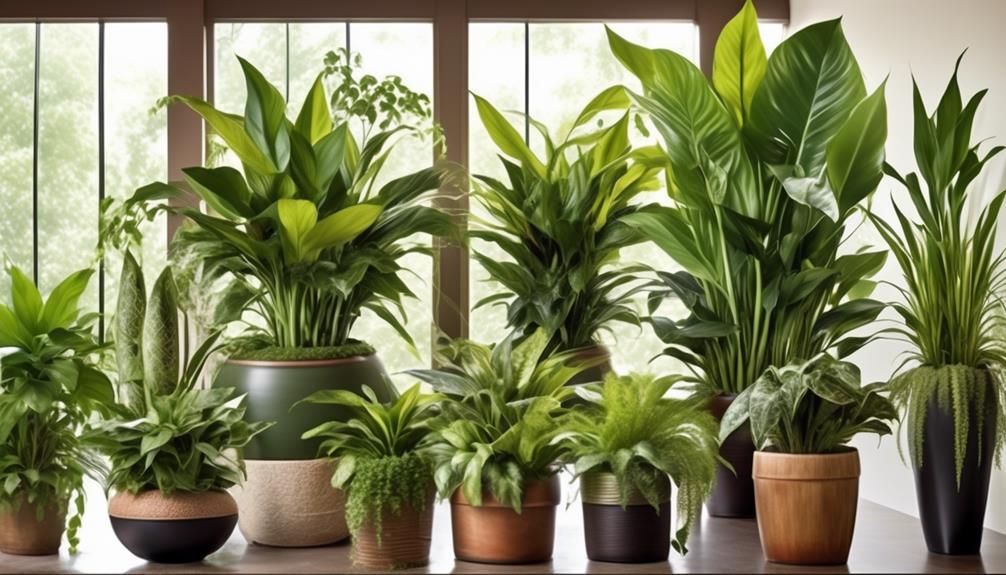
When selecting plants for self-watering pots, it's essential to choose species that are well-suited to consistent moisture and thrive in a more controlled watering environment. Best indoor plants for self-watering pots include peace lilies, spider plants, pothos, and snake plants. These plants are adaptable to indoor conditions and are known for their ability to thrive in consistently moist soil.
Peace lilies, for example, are resilient and can handle a variety of light conditions, making them suitable for different indoor environments. Spider plants are also well-suited for self-watering pots due to their ability to tolerate evenly moist soil. Pothos, with their heart-shaped leaves, and snake plants, known for their hardiness and air-purifying qualities, are also excellent choices for self-watering pots.
When engaging in container gardening, it's important to consider the specific needs of the chosen plants. Selecting plants that naturally prefer consistent moisture ensures better success with self-watering pots. Additionally, it's crucial to monitor the soil moisture levels regularly to adjust the watering system as needed, providing the optimal conditions for the chosen plant species.
Addressing Potential Drawbacks
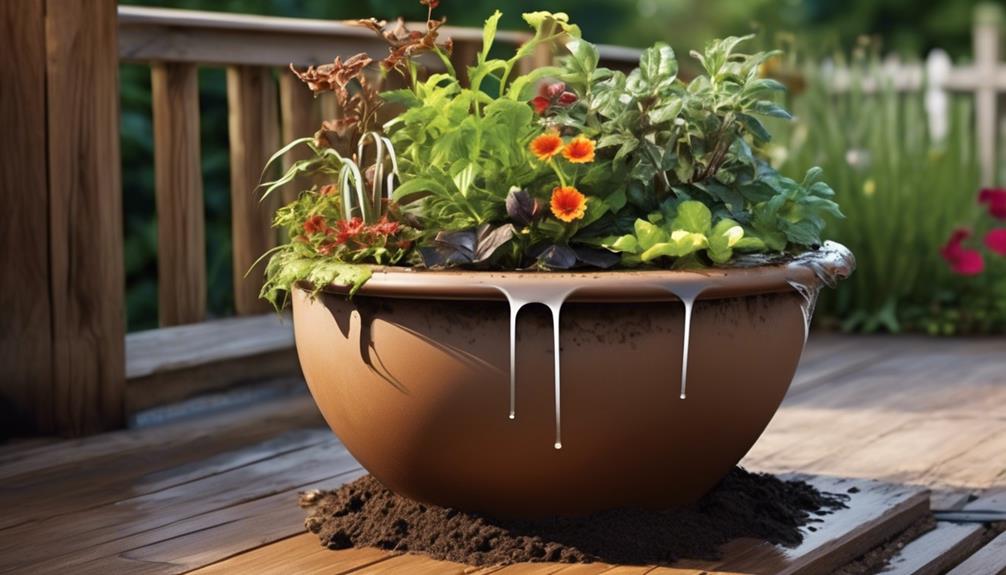
When using self-watering pots, it's important to monitor soil moisture levels to ensure the plant's health and growth. One potential drawback is the possibility of overwatering, which can lead to root rot and other issues.
Additionally, depending on the plant species, some may have specific watering needs that may not align with the self-watering pot's capabilities.
Soil Moisture Levels
While self-watering pots have been designed to maintain optimal soil moisture levels, it's important to address potential drawbacks that may affect their effectiveness.
- Watering Frequency: The self-watering system may lead to overwatering if not monitored closely, potentially causing root rot and other issues.
- Soil Moisture and Plant Growth: In certain cases, the soil moisture levels in self-watering pots may not be evenly distributed, leading to uneven plant growth and nutrient uptake.
- Maintenance Requirements: These pots may require regular cleaning and maintenance to prevent mold growth, algae, and mineral buildup, which can affect soil moisture levels and plant health.
Understanding these factors is crucial for maximizing the benefits of self-watering pots while mitigating their potential drawbacks. Regular monitoring and adjustments can help maintain healthy soil moisture levels and promote optimal plant growth.
Plant Health and Growth
To address potential drawbacks related to plant health and growth in self-watering pots, careful consideration of soil moisture distribution and maintenance requirements is essential. While self-watering pots can provide a consistent water supply, improper watering can lead to waterlogging and root rot, affecting plant health.
Additionally, the reliance on self-watering systems may result in neglecting other essential aspects of plant care, such as monitoring soil nutrition and addressing specific watering needs of different plant species. It's crucial to understand that while self-watering pots can be beneficial, they don't eliminate the need for regular monitoring and maintenance.
Furthermore, soil nutrition plays a critical role in plant growth, and the automatic watering system may not always provide sufficient nutrients. Therefore, supplementing with appropriate fertilizers is necessary to ensure optimal plant health and growth in self-watering pots.
Tips for Optimal Plant Health

Implementing a consistent watering schedule and monitoring soil moisture levels are crucial for maintaining optimal plant health in self watering pots. To ensure the best conditions for your plants, here are three essential tips to consider:
- Optimal Watering Schedule: Establishing a regular watering routine is essential for plant health. Self watering pots can sometimes lead to overwatering, so it's important to adjust the watering schedule based on the specific needs of each plant. Factors such as plant type, pot size, and environmental conditions should be taken into account when determining the frequency of watering.
- Proper Drainage Techniques: While self watering pots can help regulate moisture, it's still important to ensure proper drainage. This can be achieved by using a well-draining potting mix and monitoring the water level in the reservoir to prevent waterlogging. Adequate drainage is crucial for preventing root rot and other water-related issues.
- Soil Moisture Monitoring: Regularly check the moisture levels in the potting mix to avoid both overwatering and underwatering. Utilize moisture meters or simply feel the soil to gauge its moisture content. Understanding the moisture needs of your plants is vital for maintaining their overall health and vitality.
DIY Self-Watering Pot Options
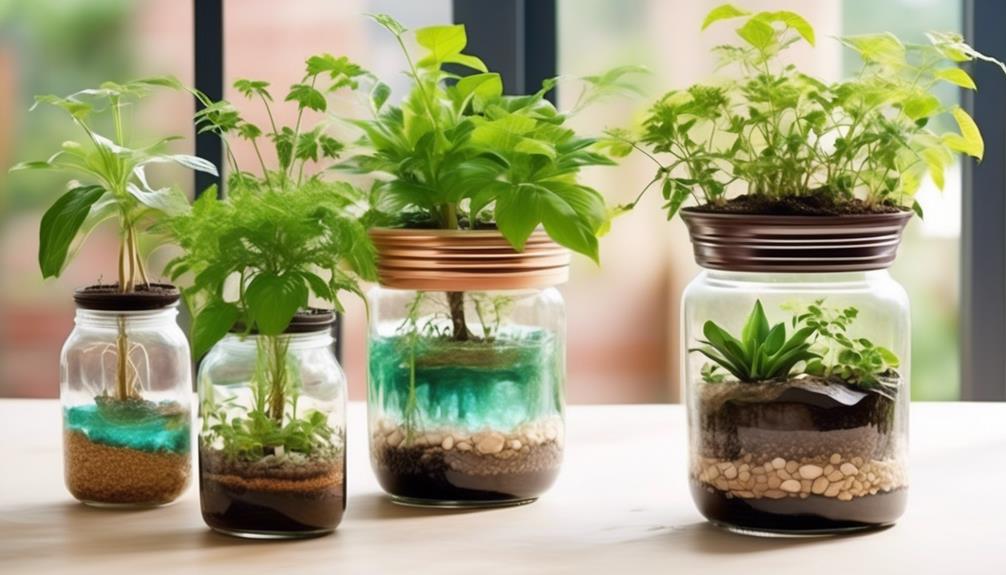
When considering DIY self-watering pot options, it's important to understand the benefits of creating one yourself. This includes the ability to customize the size and design of the pot to fit your specific needs. Additionally, DIY self-watering pots can be more cost-effective compared to purchasing pre-made ones.
Next, it's essential to know the materials required for the project. This typically includes a plastic container or pot with a lid or reservoir, a wicking material such as cotton or felt, and a water source such as a tube or bottle. It's also helpful to have a drill or other tools for creating holes in the pot for water flow.
Finally, having a step-by-step guide for construction is crucial. This can be found in various online resources or gardening books. The guide will walk you through the process of assembling the pot, including drilling holes, placing the wicking material, and connecting the water source. Following the guide ensures that the self-watering pot is built correctly and functions effectively.
Benefits of DIY
In our exploration of DIY self-watering pot options, it's essential to consider the practical benefits and potential drawbacks of creating your own self-watering system for plants.
When it comes to the benefits of the do-it-yourself approach, there are several key advantages to consider:
- Customization: DIY self-watering pots allow for customization based on the specific needs of different plants, ensuring optimal growing conditions.
- Cost-Effectiveness: Creating your own self-watering system can be a more budget-friendly option compared to purchasing commercially available self-watering pots.
- Environmental Impact: By using recycled materials or repurposing existing containers for DIY self-watering pots, you can contribute to reducing waste and minimizing your environmental footprint.
These benefits highlight the practical advantages of taking a DIY approach to self-watering pots, offering both customization and sustainability.
Materials Required
To create a DIY self-watering pot, one must gather specific materials that are essential for constructing an effective and efficient self-watering system for plants. The key materials needed for this DIY project include a water reservoir, a potting container, a wicking mechanism, and a potting mix. The benefits of using self-watering pots are numerous, including consistent moisture levels, reduced water wastage, and improved plant health. When selecting the potting mix, it is important to choose options with excellent moisture retention properties such as peat moss, coconut coir, or vermiculite. These materials aid in maintaining the proper balance of air and water in the soil, promoting healthy root growth. Here's a table outlining the essential materials required for a DIY self-watering pot:
| Materials | Purpose |
|---|---|
| Water reservoir | Stores water for self-watering system |
| Potting container | Holds the plant and water reservoir |
| Wicking mechanism | Draws water from reservoir to soil |
Step-By-Step Guide
Utilizing the essential materials outlined in the previous subtopic, we can begin constructing a DIY self-watering pot to effectively maintain plant moisture levels and promote healthy root growth. Follow these steps to create your own self-watering pot:
- Prepare the Reservoir:
Drill a hole near the bottom of the outer container for water access and place a water reservoir, such as a plastic bottle, inside.
- Insert the Wicking Material:
Thread a piece of cotton rope through the hole into the soil, allowing it to draw water from the reservoir to the plant's roots.
- Fill with Soil and Plant:
Fill the outer container with soil, ensuring the wick is in contact with it, and plant your chosen greenery.
The Environmental Impact
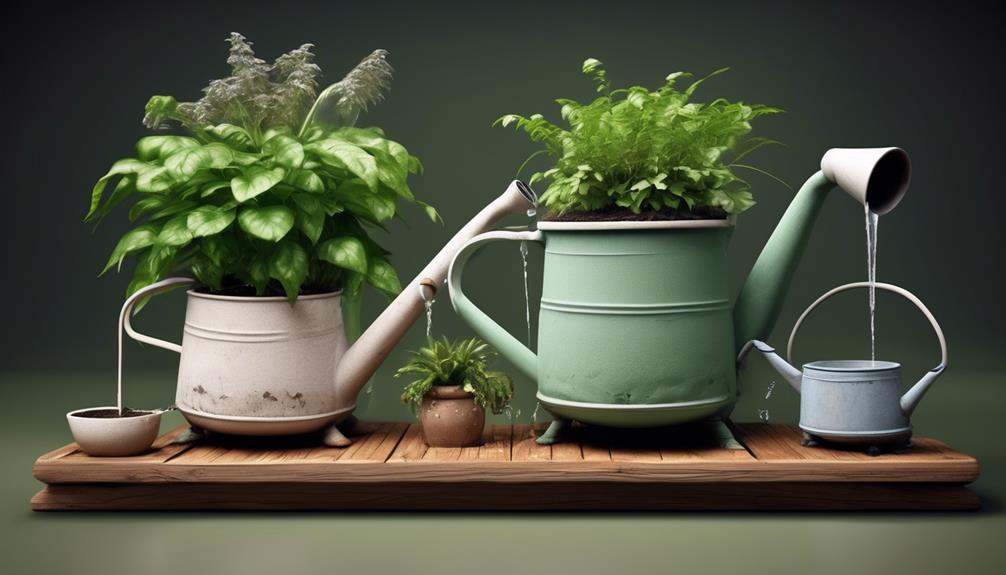
While the concept of self-watering pots may seem promising for reducing water usage and promoting plant growth, it's essential to carefully evaluate their environmental impact to determine their overall sustainability.
The environmental impact of self-watering pots must be considered in terms of water conservation and the materials used in their construction. These pots have the potential to conserve water by reducing evaporation and preventing water runoff. However, the production of self-watering pots involves the use of plastics and other materials that may have a negative environmental impact.
Additionally, the longevity and recyclability of these pots must be taken into account to assess their overall environmental footprint.
To accurately evaluate the environmental impact of self-watering pots, a life cycle assessment considering their production, usage, and disposal is necessary. This assessment should include factors such as energy consumption, greenhouse gas emissions, and waste generation associated with these pots.
Furthermore, the potential benefits of using self-watering pots for water conservation must be weighed against their environmental drawbacks to make an informed decision regarding their sustainability.
Real User Experiences
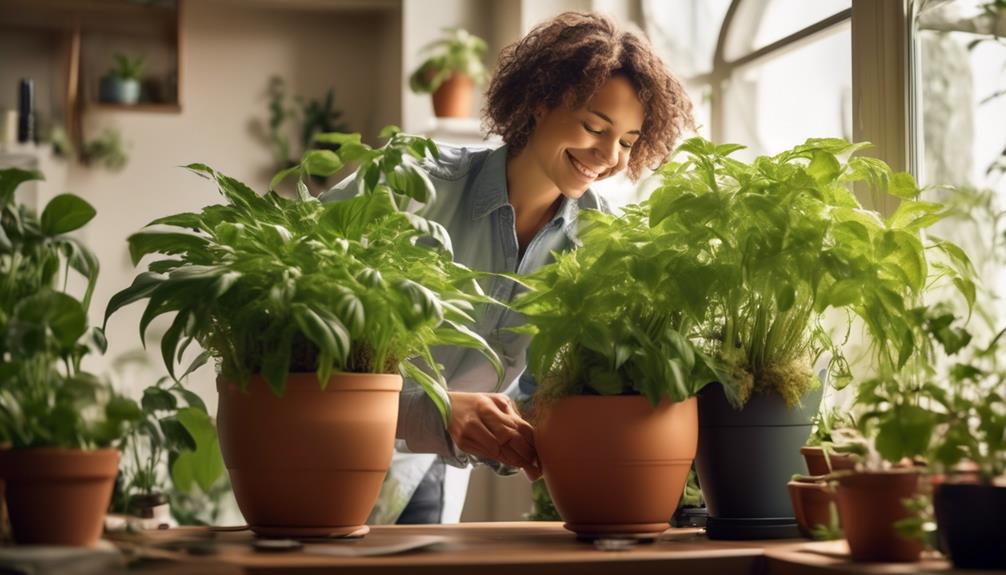
Considering the potential environmental impacts of self-watering pots, users have reported a range of experiences with these innovative planters. Our analysis of real user experiences with self-watering pots reveals the following insights:
- User Satisfaction and Watering Frequency:
Many users have expressed satisfaction with self-watering pots, noting that these planters have significantly reduced the frequency of watering required. The convenience of not having to water plants daily has been a major factor in user satisfaction. However, some users have reported the need to monitor the water level in the reservoir regularly to ensure optimal plant hydration.
- Plant Growth and Water Consumption:
Users have observed improved plant growth when using self-watering pots. The consistent moisture levels provided by these pots have resulted in healthier and more vibrant plants. Additionally, users have noted that self-watering pots tend to consume water more efficiently, as the reservoir system prevents excess water loss through evaporation and drainage.
- Overall Convenience and Practicality:
A common sentiment among users is the convenience and practicality of self-watering pots, especially for individuals with busy schedules or those who may not have a green thumb. The ease of maintaining plants in self-watering pots has been a key factor in their widespread adoption.
Frequently Asked Questions
Can Self-Watering Pots Be Used for Outdoor Gardening?
Yes, self-watering pots can be used for outdoor gardening. They provide a convenient and efficient way to maintain soil moisture, which is crucial for plant health.
These watering systems reduce the frequency of manual watering, making outdoor maintenance more manageable. By regulating water intake, self-watering pots help create an optimal growing environment for plants.
Are Self-Watering Pots Suitable for All Types of Plants, Including Succulents and Cacti?
When caring for succulents, it's key to maintain optimal watering frequency. Self-watering pots can provide steady moisture, but suitability varies by plant type.
Succulents, with low water needs, may thrive in these pots, but proper drainage is crucial.
We'll analyze whether self-watering pots are suitable for all plant types and discuss succulent care, including watering frequency, to provide a comprehensive understanding of their effectiveness for different species.
How Long Do Self-Watering Pots Typically Last Before Needing to Be Replaced?
Self-watering pots typically last a long time before needing replacement, depending on water consumption and maintenance. The durability and cost-effectiveness of these pots make them a practical choice.
Regularly checking the water level and adhering to a maintenance schedule can extend their lifespan. Understanding the specific needs of different plants is crucial for maximizing the benefits of self-watering pots.
These factors contribute to the overall effectiveness and longevity of self-watering pots.
Can Self-Watering Pots Be Used in Conjunction With Traditional Watering Methods?
Yes, self-watering pots can be used alongside traditional watering methods to enhance watering efficiency and maintain optimal soil moisture.
This dual approach can support robust plant growth and encourage healthy root development.
Are Self-Watering Pots Safe for Use Around Pets and Children?
Yes, self-watering pots are safe for use around pets and children. Safety concerns are minimal due to the design that prevents water spillage and minimizes the risk of accidental ingestion.
Their effectiveness comparison to traditional watering methods also shows promising results.
It's important to note that proper maintenance and supervision are still necessary, but overall, these pots provide a convenient and secure option for households with pets and children.
Are Self Watering Pots Effective for Keeping Plants Hydrated?
Yes, self watering pots effectiveness varies depending on the plant and environmental factors. These pots can help maintain proper hydration levels by providing consistent moisture, but it’s important to monitor soil moisture and adjust watering frequency accordingly. In general, self watering pots can be effective at keeping plants hydrated.
Conclusion
In conclusion, self-watering pots are a viable option for maintaining the health of your plants.
While some may be skeptical of their effectiveness, the science behind self-watering pots and the positive real user experiences demonstrate their ability to provide consistent hydration to your plants.
By understanding the factors that affect pot effectiveness and choosing the right potting mix, you can ensure optimal plant health and growth with self-watering pots.

